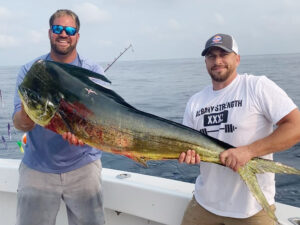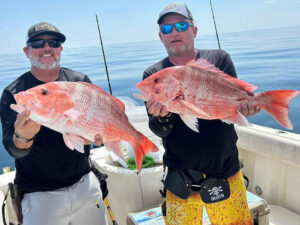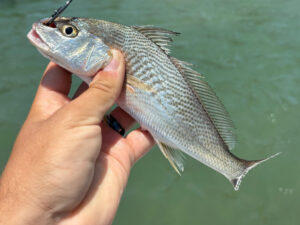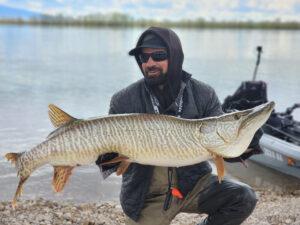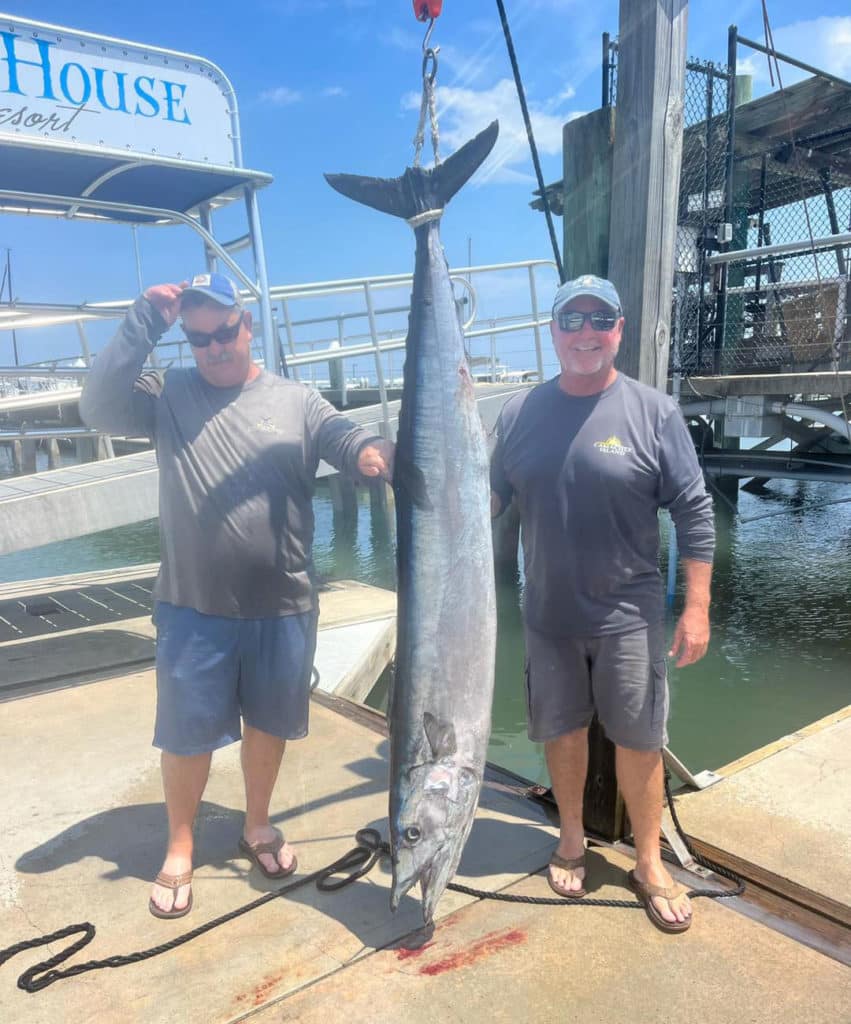
It was a perfect late-summer day for running offshore and probing deep reefs for bottom-hugging flounder. So, St. Augustine anglers Jon Herring, 58, and Fred Miles, 57, took advantage of it and ran out of the Ancient City. They settled their 21-foot Contender boat over a reef 17 miles offshore in 73 feet of water where a “live bottom” reef is noted for holding flat fish.
They were rigged right for it, with a cooler full of whole mullet baits from which strips could be cut and sent deep for flounder.
That’s when a giant wahoo suddenly showed just 15 feet from their boat.
“I yelled ‘Whoa, look at that the size of that one’,” says Herring, as the ‘lit up’ fish eased passed them, it’s radiant blue flanks clearly showing in the clear water. “I didn’t even want to try and catch the fish because we didn’t have wire leader to prevent leader cut offs. But Fred said, ‘give me a bait,’ and he rigged it on a jig head to his heaviest fishing outfit – which was still light – and flipped it to the circling wahoo.”
The big wahoo ate the 9-inch mullet immediately, and instantly severed the 80-pound test fluorocarbon leader attached to the bait, said Herring. But the fish didn’t leave. It just circled the boat, above the reef, looking for another meal.
Miles rigged another mullet, tossed it to the wahoo, with the same result. Time after time he rigged a bait, flipped it to the still-circling wahoo, and each time the fish wolfed down the bait, cutting the line like a hot knife through butter. But it continued circling their boat.
“We had one bait left, about a 12-inch live whiting we’d caught earlier on a strip bait and tossed into the live well,” explained Herring. “Fred hooked it through the nose with a 7/0-circle hook, and pitched it to the wahoo as it swam by us just 15 feet away.”
The wahoo took the bait, and the circle hook did its job by barbing the fish on the side of the mouth – its metal shank preventing the wahoo’s razor-sharp teeth from cutting the line again.
The medium-action flounder rod bent tight, and 40-pound test braided line ripped off his Daiwa “Saltist” 30-class level-wind reel, as the wahoo kicked into high gear and raced away.
Herring quickly pulled up the Contender’s Spot Lock bow-mount electric motor, cranked the big engine and gave chase to the racing wahoo.
“The fish nearly dumped all the line on the reel, and it took awhile to gain on the fish and get it close again,” says Herring, who manned the boat controls. “The wahoo stayed close to the surface until we got near it, then it went down about 30 feet, made another run, and we pretty much got control after that.”
The veteran anglers worked the boat, rod, and hooked fish just right, and about 20 minutes later the wahoo was at the surface, beat, and ready to be brought aboard. But they had no large gaff, only a small homemade gaff designed for handling small fish like flounder. It was made from an old golf club handle with about an 8/0 hook (having no barb) fitted in one end for small fish gaffing duty.
“That little gaff is all we had, so I used it and hit the wahoo near the tail, on the other end of those razor teeth,” said Herring. “Then I muscled it into the boat, Fred dropped his rod, grabbed the fish, too, and we put it onto the deck.
“Then we started jumping up and down like a couple of kids, laughing and yelling, back slapping and smiling.”
They loaded the fish into their cooler, but a couple feet of the tail wouldn’t fit. So they rearranged ice on it as best they could, then ran back to shore to weigh it and get it properly cooled before it spoiled in the Florida August sun.
Back at Camachee Cove Yacht Harbor in St. Augustine the fish weighed 86.7-pounds – a giant of a wahoo, even for St. Augustine, which annually gives up massive wahoo every winter, some weighing over 100 pounds.
But catching wahoo off the Ancient City in summer is a rarity, especially fish of such size. But Herring says a “temperature inversion” occurs every late summer off Northeast Florida, where cool water pushes in and that may have been why such a massive wahoo was so close to shore during the heat of August in Florida.
Asked about catching such a huge wahoo on such light flounder tackle, Miles was matter of fact.
“Braided line was the great equalizer,” he said about catching the wahoo. “And a lot of luck.”

